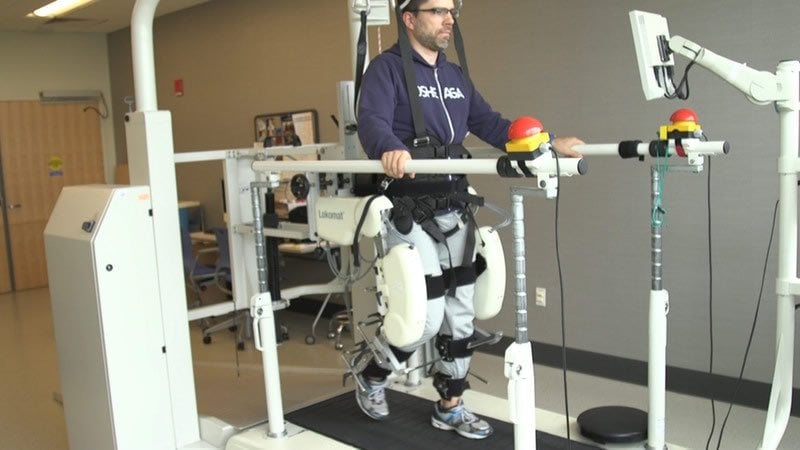Summary: Using robotics, researchers uncover mechanisms in the cerebellum and spinal cord that determine how the nervous system responds to induced changes in step length. The findings could have implications for physical rehabilitation programs for people with movement disorders.
Source: Wyss Institute
Many of us aren’t spending much time outside lately, but there are still many obstacles for us to navigate as we walk around: the edge of the coffee table, small children, the family dog. How do our brains adjust to changes in our walking strides? Researchers at the Wyss Institute for Biologically Inspired Engineering at Harvard University and the Motion Analysis Laboratory at Spaulding Rehabilitation Hospital used robots to try to answer that question, and discovered that mechanisms in both the cerebellum and the spinal cord determine how the nervous system responds to robot-induced changes in step length. The new study is published in the latest issue of Scientific Reports, and points the way toward improving robot-based physical rehabilitation programs for patients.
“Our understanding of the neural mechanisms underlying locomotor adaptation is still limited. Specifically, how behavioral, functional, and physiological processes work in concert to achieve adaptation during locomotion has remained elusive to date,” said Paolo Bonato, Ph.D., an Associate Faculty member of the Wyss Institute and Director of the Spaulding Motion Analysis Lab who led the study. “Our goal is to create a better understanding of this process and hence develop more effective clinical interventions.”
Researchers study how our brains adjust to changes in our walking strides, gaining insights that could be used to develop better physical rehabilitation programs. Credit: Wyss Institute.
For the study, the team used a robot to induce two opposite unilateral mechanical perturbations to human subjects as they were walking that affected their step length over multiple gait cycles. Electrical signals recorded from muscles were collected and analyzed to determine how muscle synergies (the activation of a group of muscles to create a specific movement) change in response to perturbation. The results revealed a combination of feedforward control signals coming from the cerebellum and feedback-driven control signals arising in the spinal cord during adaptation. The relative side-specific contributions of the two processes to motor-output adjustments, however, depended on which type of perturbation was delivered. Overall, the observations provide evidence that, in humans, both descending and afferent drives project onto the same spinal interneuronal networks that encode locomotor muscle synergies.

These results mirror previous observations from animal studies, strongly suggesting the presence of a defined population of spinal interneurons regulating muscle coordination that can be accessed by both cortical and afferent drives in humans. “Our team hopes to build on this work to develop new approaches to the design of robot-assisted gait rehabilitation procedures targeting specific descending- and afferent-driven responses in muscle synergies in the coming year,” said Bonato.
Source:
Wyss Institute
Media Contacts:
Tim Sullivan – Wyss Institute
Image Source:
The image is credited to Wyss Institute at Harvard University.
Original Research: Open access
“Robot-Driven Locomotor Perturbations Reveal Synergy-Mediated, Context-Dependent Feedforward and Feedback Mechanisms of Adaptation”. Giacomo Severini, Alexander Koenig, Catherine Adans-Dester, Iahn Cajigas, Vincent C. K. Cheung & Paolo Bonato.
Scientific Reports doi:10.1038/s41598-020-61231-8.
Abstract
Robot-Driven Locomotor Perturbations Reveal Synergy-Mediated, Context-Dependent Feedforward and Feedback Mechanisms of Adaptation
Humans respond to mechanical perturbations that affect their gait by changing their motor control strategy. Previous work indicates that adaptation during gait is context dependent, and perturbations altering long-term stability are compensated for even at the cost of higher energy expenditure. However, it is unclear if gait adaptation is driven by unilateral or bilateral mechanisms, and what the roles of feedback and feedforward control are in the generation of compensatory responses. Here, we used a robot-based adaptation paradigm to investigate if feedback/feedforward and unilateral/bilateral contributions to locomotor adaptation are also context dependent in healthy adults. A robot was used to induce two opposite unilateral mechanical perturbations affecting the step length over multiple gait cycles. Electromyographic signals were collected and analyzed to determine how muscle synergies change in response to perturbations. The results unraveled different unilateral modulation dynamics of the muscle-synergy activations during adaptation, characterized by the combination of a slow-progressive feedforward process and a fast-reactive feedback-driven process. The relative unilateral contributions of the two processes to motor-output adjustments, however, depended on which perturbation was delivered. Overall, these observations provide evidence that, in humans, both descending and afferent drives project onto the same spinal interneuronal networks that encode locomotor muscle synergies.






